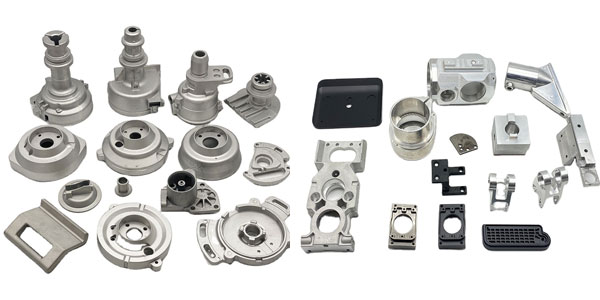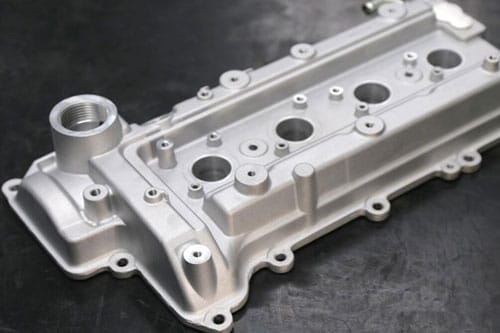How Metal Castings support innovation in different industries
Wiki Article
Everything About Light Weight Aluminum Castings: Understanding Their Function and Relevance in Production
Light weight aluminum spreadings are important to modern-day production, offering a blend of lightweight buildings and sturdiness. They promote complicated designs while reducing assembly expenses. Industries such as aerospace and automobile regularly use these elements for enhanced performance. Nonetheless, the production of light weight aluminum castings is not without its obstacles. Understanding the nuances of this procedure discloses both the benefits and prospective mistakes. Checking out these factors will supply deeper insights right into their expanding significance.Review of Light Weight Aluminum Spreading Processes
Aluminum casting procedures play a vital duty in manufacturing, supplying adaptability and efficiency. These processes entail putting molten aluminum into mold and mildews to produce specific shapes and elements. Numerous strategies are used, consisting of sand casting, die spreading, and investment casting, each identified by its method of mold production and the desired application.Sand casting uses a blend of sand and binder to form molds, permitting complicated geometries. Die spreading, on the other hand, includes requiring molten aluminum into metal molds, leading to high accuracy and smooth coatings. Financial investment spreading, frequently utilized for complex designs, includes creating a wax pattern covered with a ceramic covering, which is after that full of molten light weight aluminum.
These casting approaches satisfy varied commercial demands, making light weight aluminum a recommended product for parts in sectors such as automobile, aerospace, and consumer goods. The choice of casting strategy substantially influences the end product's quality and efficiency.
Advantages of Utilizing Aluminum Castings
The advantages of making use of light weight aluminum spreadings in manufacturing are considerable and many. To start with, light weight aluminum's lightweight nature adds to minimized overall product weight, enhancing power efficiency in applications such as automobile and aerospace industries. In addition, aluminum spreadings display exceptional corrosion resistance, guaranteeing durability and resilience in severe settings. The material's electric and thermal conductivity also makes it suitable for various applications, consisting of electronic devices and warm exchangers.Additionally, light weight aluminum spreadings can be produced with complex styles, enabling for a lot more intricate forms that fulfill particular practical needs. This adaptability adds to lowered setting up prices and boosted style versatility. The casting process itself is efficient, enabling for high-volume production with consistent quality. Aluminum is recyclable, making it an eco pleasant alternative in production. Collectively, these benefits highlight why aluminum spreadings are significantly favored across varied fields, supplying both efficiency advantages and financial efficiency.
Usual Applications of Aluminum Castings
While various products are made use of in production, light weight aluminum spreadings attract attention because of their wide variety of applications across multiple industries. These castings are extensively made use of in the automotive industry for engine parts, transmission housings, and structural components, contributing to lighter cars and improved gas performance. In the aerospace sector, light weight aluminum castings are critical for airplane components, where weight decrease is vital for performance and security.Furthermore, the electrical sector utilizes light weight aluminum spreadings for real estates and structural aspects in equipment, taking advantage of the material's superb conductivity. In customer items, aluminum castings can be found in items such as devices and showing off equipment, offering longevity and a modern visual. Furthermore, the building and construction sector makes use of aluminum spreadings in building components, window structures, and components, showcasing their convenience and stamina. Overall, light weight aluminum spreadings play an indispensable duty in enhancing product efficiency and efficiency throughout various industries.
Key Manufacturing Techniques for Aluminum Castings
The production of light weight aluminum castings relies upon various strategies, with sand spreading and pass away spreading being among one of the most prominent. Sand spreading involves creating mold and mildews from sand, enabling complex layouts and large elements. In comparison, pass away casting makes use of high-pressure injection of liquified aluminum right into recyclable molds, using accuracy and efficiency for mass production.Sand Spreading Process
Sand casting stands as one of the most widely made use of methods for creating light weight aluminum castings, many thanks to its adaptability and cost-effectiveness. This process involves producing a mold from a mixture of sand and a bonding representative, typically clay. When the mold is prepared, liquified light weight aluminum is put right into it, allowing the steel to fill up the tooth cavity. After cooling, the mold and mildew is broken away to reveal the spreading. Sand casting suits large parts and complex geometries, making it ideal for numerous applications. In addition, it enables easy adjustments, making it possible for producers to change designs quickly. Nonetheless, the surface finish might call for extra machining for precise applications, ensuring the final item meets quality standards.Pass Away Spreading Approaches
Pass away casting represents an extremely effective approach for producing light weight aluminum castings, defined by its capability to provide high precision and excellent surface coating. This technique largely includes requiring liquified light weight aluminum into a mold under high pressure, ensuring that intricate shapes and great information are captured accurately. There are 2 major die casting approaches: warm chamber and chilly chamber. Hot see chamber pass away spreading is suitable for alloys with reduced melting factors and permits faster cycles, while chilly chamber pass away casting is ideal for high-temperature alloys, needing different melting systems. Both approaches boost manufacturing rates and reduce product waste, making die casting a favored option in sectors such as vehicle and electronics, where sturdiness and dimensional accuracy are critical.Sustainability in Aluminum Spreading Production
While the demand for light weight aluminum spreadings remains to grow, producers are progressively focusing on sustainability in their manufacturing processes. This change is driven by the demand to lower environmental impact and conserve natural deposits. Lots of business are taking on reusing initiatives, using scrap aluminum, which notably decreases power usage and greenhouse gas exhausts contrasted to primary aluminum manufacturing. Furthermore, advancements in casting modern technologies are enabling much more efficient usage of materials, minimizing waste during the production procedure.Makers are additionally discovering environment-friendly alternatives to standard casting techniques, such as 3D printing and advanced mold and mildew innovations, which help enhance resource use. Wisconsin Aluminum Foundry. In enhancement, carrying out sustainable practices in supply chain administration assurances that raw materials are sourced sensibly. Consequently, the aluminum spreading market is making strides toward a much more sustainable future, straightening with global environmental objectives while fulfilling the raising demand for high-performance aluminum products
Difficulties and Considerations in Aluminum Casting
Light weight aluminum casting presents different difficulties that manufacturers must navigate to assure product integrity. Design complexity can make complex the casting procedure, leading visit this page to potential issues and increased manufacturing time. In addition, keeping rigorous quality assurance criteria is necessary to fulfill the demands of precision and reliability in finished elements.
Layout Complexity Issues
Designing parts for light weight aluminum spreading presents different intricacies that engineers need to browse to accomplish optimal results. One significant difficulty is the requirement for specific geometry; intricate designs can result in troubles in mold production and boosted risk of defects. Furthermore, thermal residential properties of light weight aluminum necessitate careful factor to consider of cooling down prices, as unequal air conditioning can cause warping. Wall surface thickness variants likewise pose a difficulty, as they can influence circulation features and structural stability. Engineers should stabilize style visual appeals with manufacturability, guaranteeing that features such as fillets and ribs are maximized for toughness without making complex the casting process. Considerations pertaining to draft angles are vital to help with mold and mildew release, more making complex the design process. These variables jointly emphasize the complexities entailed in light weight aluminum casting design.Top Quality Control Difficulties
Achieving top notch light weight aluminum spreadings entails steering a range of quality assurance obstacles that can substantially affect the final product. First, variants in basic material make-up can cause inconsistencies in casting properties, making it vital to guarantee worldly high quality. Second, the spreading procedure itself is prone to issues, such as porosity and shrinking, which can jeopardize structural integrity. Additionally, temperature level control throughout melting and pouring is essential; variations can cause irregular solidification, affecting dimensional accuracy. Moreover, comprehensive assessment techniques, consisting of non-destructive testing, have to be employed to recognize problems early. Maintaining rigorous procedure documents and adherence to industry criteria is essential for traceability and top quality assurance, highlighting the detailed equilibrium needed to generate trusted aluminum castings in manufacturing.Future Trends in Light Weight Aluminum Casting Innovation
As makers strive to improve performance and sustainability, innovations in light weight aluminum spreading innovation are arising to fulfill these needs. One significant trend is the assimilation of automation and expert system, which streamline manufacturing processes and boost accuracy in casting operations. These improvements decrease human mistake and optimize resource usage, ultimately leading to set you back decreases.Additionally, the adoption of innovative materials and alloys is improving the landscape. New solutions enhance efficiency qualities, such as deterioration resistance and light-weight residential properties, making aluminum spreadings much more functional across different markets.
Sustainable methods are acquiring traction, with an emphasis on recycling and lessening waste (Aluminum Castings). Techniques such as 3D printing are likewise being checked out to create complicated geometries that were formerly unattainable
Frequently Asked Inquiries

Exactly How Do Light Weight Aluminum Castings Contrast to Various Other Materials?
Aluminum castings use benefits such as light-weight, deterioration resistance, and outstanding thermal conductivity contrasted to other materials. They are often chosen for applications requiring longevity and performance, particularly in aerospace and vehicle industries.What Is the Life Expectancy of Light Weight Aluminum Castings?
The life-span of light weight aluminum castings normally ranges from 10 to half a century, relying on ecological conditions, usage, and upkeep. Their deterioration resistance and longevity contribute significantly to their durable efficiency in numerous applications.Can Aluminum Castings Be Recycled?
Yes, light weight aluminum castings can be reused. The recycling process is effective, allowing for the recovery of aluminum without significant loss of top quality, making it a lasting choice in production and decreasing ecological effect.What Precaution Are Needed During Aluminum Casting?
Throughout light weight aluminum spreading, important safety procedures include using appropriate personal protective tools, making sure proper air flow, keeping devices, utilizing fireproof materials, and carrying out risk-free dealing with methods visit homepage for liquified metal to avoid mishaps and injuries.How Do Temperature Changes Impact Light Weight Aluminum Castings?
Temperature changes substantially impact light weight aluminum castings by affecting fluidity, solidification prices, and mechanical residential properties. Quick cooling can result in increased brittleness, while gradual air conditioning promotes far better structural integrity and lowers the threat of defects.Die spreading, on the other hand, involves forcing liquified aluminum into metal molds, resulting in high accuracy and smooth surfaces. The manufacturing of aluminum castings relies on different strategies, with sand casting and pass away casting being amongst the most popular. Sand casting stands as one of the most commonly utilized approaches for creating light weight aluminum spreadings, thanks to its convenience and cost-effectiveness. Pass away spreading stands for an extremely reliable technique for producing aluminum castings, characterized by its ability to supply high accuracy and outstanding surface area coating. While the demand for aluminum spreadings proceeds to grow, makers are increasingly focusing on sustainability in their production procedures.
Report this wiki page